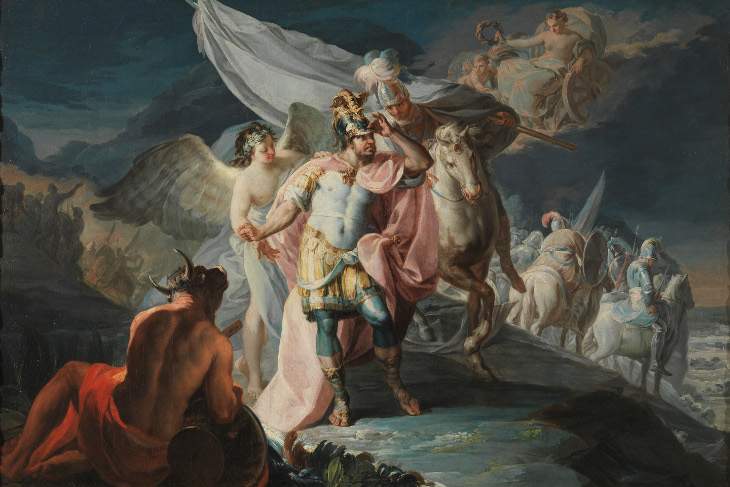Prado strike: Madrid museum acquires first documented work by Goya
Important coup for the Museo del Prado, which has acquired the first documented work by Francisco de Goya y Lucientes (Fuendetodos, 1746 - Bordeaux, 1828): it is the painting Aníbal vencedor, que por primera vez mira Italia desde los Alpes (“Hannibal the victor who for the first time looks at Italy from the Alps”). This is a major acquisition because it definitively completes one of the scarce chronological gaps related to the artist in the Madrid museum’s collection (it is the most important collection of Goya’s works in the world). The painting is a key work from the early phase of the artist’s career.
The work arrives at the Prado thanks to a donation from the Fundación Amigos del Museo del Prado (which materially acquired the painting, for the sum of 3.3 million euros), in honor of Professor Francisco Calvo Serraller, one of the founding members of the association and also director of the Prado when, in 1993, art historian Jesús Urrea attributed the painting to Goya. The donation stands as the first commemorative act of the 40th anniversary of the establishment of the Fundación Amigos del Museo del Prado: the celebrations will continue with the publication of a book on its history and culminate in an exhibition in the halls of the Prado, where for the first time the works donated by the Fundación to the Prado over four decades of activity can be seen together.
The painting with Hannibal the Winner, painted in 1771 when the artist was in his mid-20s, is described by the Prado as “a painting of undoubted technical perfection, which stands as a manifesto for its harmonious compositional order, its excellent luministic treatment, and the confidence and firmness of the brushstroke in shaping the figures with color and light.” The work dates from the years of Goya’s Italian sojourn (1769-1771) and is also a significant acquisition due to the fact that the Prado already possesses the Cuaderno italiano, or notebook of Goya’s drawings that the painter executed precisely during his Italian years: among the sheets is preserved one with a compositional idea of thevictorious Hannibal and others where studies for his main figures (such as the head of the bull in the allegory of the Po) are noted.
Goya painted thewinning Hannibal in Rome in 1771 to take part in the competition of the Royal Academy of Fine Arts in Parma: the Spanish artist did not win, as it was Paolo Borroni (Voghera, 1749 - 1819) who took the victory, but he still managed to get six votes and a special mention, and his name was mentioned in the January 1772 edition of the magazine Le Mercure de France, where the results of the competition were published. The work is an example of Goya’s early contacts with the world of the academies (and, in particular, the Italian academies), important in that they paved the way for the great artist’s career. Thevictorious Hannibal also demonstrates Goya’s ability to adapt to the aesthetics and beliefs of the academic world: in fact, it is one of the first known occasions in which Goya tackled a painting of a historical character, and what is more, with a very complex composition.
As mentioned, Goya prepared himself with a series of drawings that are part of the Cuaderno italiano, as well as with at least two oil sketches preserved today-one in the Museum of Zaragoza and one in a private collection in New York: theprocess Goya followed in preparing it certifies the importance the artist attached to his project, and it also reflects the different sources of inspiration Goya looked to during his stay in Rome, for example the works of Corrado Giaquinto (Molfetta, 1703 - Naples, 1766) and ancient statues such as theApollo del Belvedere or the Dying Galata.
“The work,” the Prado continues, “is fundamental for getting to know Goya. It shows in fact his way of conceiving figures that will also return in future genre or history paintings, his way of organizing pictorial space through effects of light and color, and his way of defining with perfection the anatomies and various surfaces of objects. Moreover, even in the technique, characterized by economy, strength and precision, the artist’s mastery and exceptionality is already revealed.” The work, the museum concludes, “plays an important role in the Prado’s collections. These early years constitute the era of Goya’s career for which the institution has a more restricted collection.”
 |
| Prado strike: Madrid museum acquires first documented work by Goya |
Warning: the translation into English of the original Italian article was created using automatic tools. We undertake to review all articles, but we do not guarantee the total absence of inaccuracies in the translation due to the program. You can find the original by clicking on the ITA button. If you find any mistake,please contact us.



























